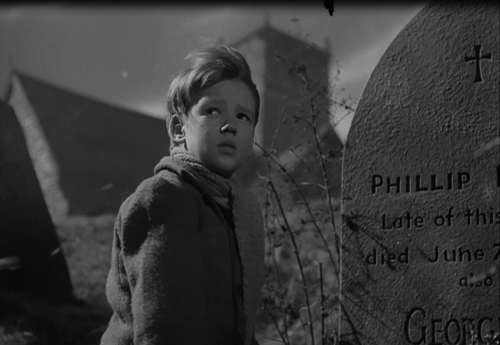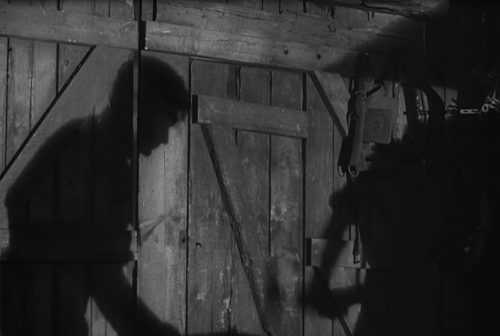Having laid out my basic schema for analyzing adaptations last week, I will here attempt to put it into practice, using a scene I’ve watched several times and have found very effective, and which comes from one of my favourite adaptations.
David Lean’s Oliver Twist (1948) is, perhaps, one of the great adaptations in cinema history. The Oxford Reader’s Companion to Dickens (Paul Schlicke, ed., 2000) reserves the highest place among all Dickens adaptations for the film, calling it “a masterpiece”, while the British Film Institute have pronounced it a “a classic of British cinema“. Among the most memorable scenes in the film is the opening, which features a heavily pregnant young woman struggling through a storm in barren moorland, following a distant light and finally falling exhausted at the gate within which the light sits. My exploration in this post will be to see where the scene, in each of its elements, “comes from”. Taking each of the four elements of the schema in turn, I will try to construct a panorama of the scene’s content, the only limit being my own breadth of knowledge.

Source Text: If one wishes to see this scene as a direct adaptation of a narrative element in Dickens, one can point to a line of dialogue from the workhouse nurse attending the young woman (who is, as we find out later in the novel, named Agnes, and the eponymous character’s mother – in the film, I don’t think we find out her name within the text at all, but only in the paratextual material of the credits).
She was brought here last night,” said the old woman, “by the overseer’s order. She was found lying in the street. She had walked some distance, for her shoes were worn to pieces; but where she came from, or where she was going, nobody knows.” (Chapter 1)
This is analepsis or flashback that comes in near the start of the story. It is what Genette would call an “external analepsis” (Narrative Discourse), meaning that it refers to an incident which lies outside the temporal boundaries of the story as told, and is only referred to in this dialogue.
I would analyze the narrative of this short analeptic passage as follows:
- The functions alluded to are: 1, Agnes being brought to the workhouse; 2, Agnes being found lying in the street; and 3, Agnes walking “some distance”. (In order as related; evidently, they occurred in the reverse order)
- There are two informants: Agnes’ shoes being “worn to pieces”; and the “realist operator” (Barthes, “Introduction to the Structural Analysis of Narrative”) that is the reference to the overseer, placing the narrative within Dickens’ contemporary England.
- There is one indice: Agnes’ tenacity and strength of purpose is implied by the fact that she had walked so far that her shoes were in tatters.
The narrative in Lean’s opening discards 2 and 3, though they remain implied by the cut from Agnes collapsing at the gate to Agnes lying in the workhouse. The informant relating to the overseer is gone (it would probably have been unintelligible to a 20th-century audience, in any case), and the informant of the shoes in pieces is also discarded; however, the indice of Agnes’ tenacity and strength of purpose remains.
Indeed, if one wished to make a wholly source-text oriented interpretation of the scene, one could say that it is an extended metaphorization of the aforementioned indice. The storm functions less in itself than in what it shows of Agnes’ strength of character. In this regard, one could argue that the scene adapts Dickens, that it is a correlative of a function in the source text. It is, however, a narratively excessive one, given the length and dramatic intensity of the scene.
Direct Author: I have already designated “Lean” as the author of the film Oliver Twist; but such a naming of authorship is never more than a synecdoche, part-for-whole. With specific reference to this scene, it needs to be noted that the idea for the scene came from Kay Walsh, who played Nancy in the film and was at the time David Lean’s wife. The importance of lighting in the scene can hardly be overestimated, either, with cameraman Guy Green using special effects to create a sky in Pinewood Studios

Similarly, Arnold Bax’s score is crucial to the effect of the scene: the disharmonious scraping of violins that accompany the cut to thorny branches as Agnes gets labour pains

It is clear, however, that both Green and Bax were micro-managed by Lean:
“Bax was great,” said John Huntley, “but totally inexperienced at film and timing and all the rest of it. So in order to try and help, David wrote the most extensive notes on what he actually wanted the music to do.”
Green thought [the shots of the sky in the opening scene] looked great in the rushes, but David [Lean] declared, “We’re going to have to retake this. It’s too romantic. I want more edginess and more storm.” (Kevin Brownlow, David Lean: A Biography, Faber and Faber, 1977, pp. 243-44, 229)
And then there’s Josephine Stuart as Agnes, the only actor in the scene, no dialogue, a purely visual presence, chosen undoubtedly as much for her physical embodiment of fresh young beauty as for her thespian ability – by her visual presence she works affectively in the role, creating sympathy for the character’s plight.

To a great extent, all of these contributions were under Lean’s control, so it remains reasonable as well as convenient to consider him author here. And author in this scene is important, as there is much that can be seen as pertaining to the direct author. In “A Profile of Oliver Twist”, the documentary on the 2000 ITV DVD release, camera operator Oswald Morris recalls the innovation of the tilting of the camera to sync with Agnes’ labour pains: “I had never seen that before. That was all David’s idea.”

The technical innovation of the scene, then, points to a strongly individualized authorial presence, which is able to interpret and work around the source text in an original and effective way, and harness the talents of various other personae working on the scene.
Generic influences: The conception of this scene is from early 20th-century cinema. Kay Walsh had a memory of “sitting in the flea pit”, and seeing a girl with “great big eyes” on the screen who sank into a ditch and died (Brownlow, p. 229). Her outline of the scene was based on this memory, and this was re-actualized in the film. But it is impossible to specify the influence Walsh had in mind.
Influence of previous Oliver Twist adaptations in this scene is minimal. Lean actually went to see the (rather poor) 1933 US adaptation starring Dickie Moore during the making of his own film, but went for a different tone entirely. Lean wanted “a grimly realistic study of what poverty was like in that time” (Gene D. Phillips, Beyond the Epic: The Life and Films of David Lean, (Lexington, KY: University of Kentucky Press, 2006), p. 123); which is reflected in the dark and moody lighting of this scene. Such lighting is film noirish, but the bleak moorland setting is not, recalling 19th-century romantic fiction and theatre more than any existing cinematic tropes. But the keys terms for Lean were historical (“in that time”) and realism – if we take the film as being a piece of historical realism, we must allow that it had few cinematic antecedents, and entered somewhat new cinematic territory.
Cultural influences: These seem to me to be entirely absent from this scene. Perhaps this is what gives it its timeless quality. There is cultural specificity visible in later parts of the film – the post-WWII/ rationing focus on food – hunger for Oliver, gluttony for the workhouse board; but it’s kept relatively subtle and indirect. But in this opening scene, I can find nothing at all. This may be partly because I am have little background knowledge of the period in question but it also points to the classicism of Lean’s approach. Lean was an aesthetic rather than a political filmmaker, less concerned with reflecting the times than with creating cinema. That’s despite the fact he made some films based (loosely) on historical fact. It’s despite the fact, too, that he conceived Oliver Twist as dealing with 19th-century poverty, as it historically appeared. The juxtaposition of this intention with the ahistoricism of the opening scene is striking, and leads me to the provisional conclusion that the past is aesthetic. Representations of the past have a different status to those of the present, and are experienced differently and, in part, aesthetically.
So the scene is Dickens plus an unknown early 20th-century film (presumably some sort of melodrama), plus individual technical innovation and an impressionistic approach to film-making: images reproducing and communicating character’s states of mind – a technique very different from Dickens, or novels in general, though it’s not too far from the poetic device of pathetic fallacy, in the phrase coined by Ruskin. There’s a dash of film noir, too. The intertext of the scene is complex, as is, indeed, the intertext of most scenes. This particular scene is interesting as it’s so patently limiting and insufficient to see it through the lens of adaptation, or posit that all it does is re-mediumize something that’s already in the book. There was nothing inevitable about the scene; if Lean hadn’t done it, it would never have been done with Oliver Twist, and would never have entered the culture-text of the novel as it has, being re-done by most subsequent adapters, as I’ve written about earlier.
And, even still, there’s lots of ways of interpreting the scene, I’m sure, that I haven’t touched upon. Yet the quadripartite framing schema I’ve used certainly opens up a scene to a detailed and fairly comprehensive reading, though it also demands a high level of circumstantial knowledge… a level which I myself, perhaps, haven’t quite reached. My knowledge of the history of cinema is not so substantial as I might wish, but I am, at least, continually pointing out directions to myself, erecting signposts on the road to critico-analytical knowledge.






















